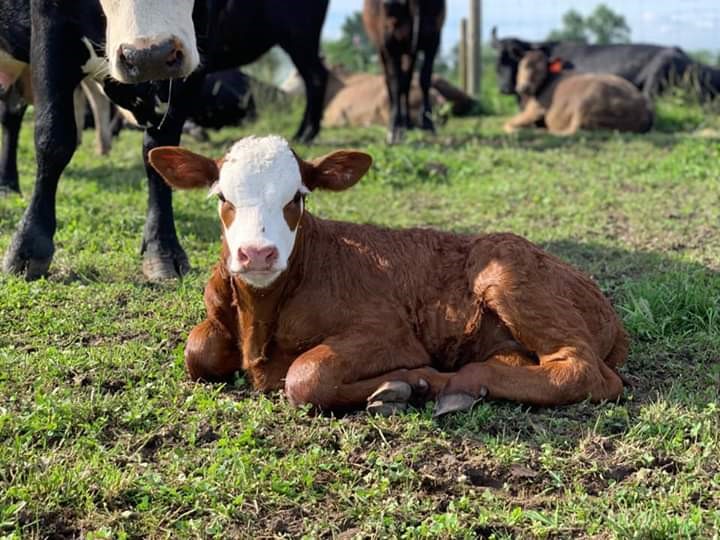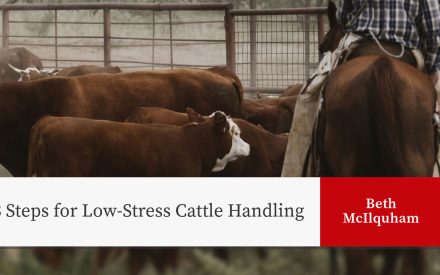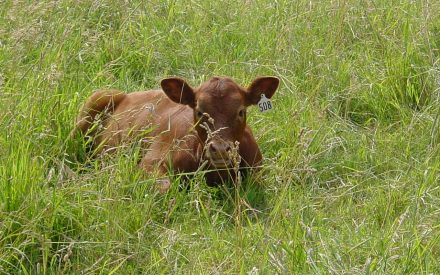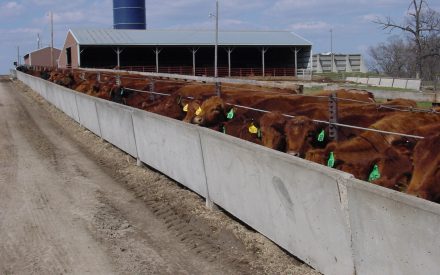There are times when cattle producers need to come to the aid of a downed animal. Daily observations should identify cattle that are unable to stand and there must be a plan in place for how to quickly respond to help these animals. The longer cattle are down, the more likely their weight and inactivity will damage circulation and nerve function to their underside muscles, which leads to a poor prognosis for recovery. More in-depth discussion is covered in the Managing the Down Cow fact sheet.

Sternal recumbency is the normal reclined position of cattle when laying. Sternum refers to the chest, recumbency refers to laying or reclining. Cattle in sternal recumbency are resting on their side with the majority of their weight resting on their front leg(s) that are folded underneath their chest while the rear legs are either both tucked up to the belly or the bottom leg is tucked while the upper rear leg extends away from their body in the same direction their head is facing .
The definition of a downed animal or downer includes animals that are unable to stand, or free themselves from a cast position. The term cast describes an animal that is lying flat on its side, over-centered, and unable to push themselves into sternal recumbency.
As described by the Merck Veterinary Manual, “non-ambulatory disabled livestock are those that cannot rise from a recumbent position or that cannot walk. This includes, but is not limited to, those with broken appendages, severed tendons or ligaments, nerve paralysis, a fractured vertebral column, or metabolic conditions.”
Monitor an animal’s recovery from illness or lameness and make preemptive marketing decisions when their progress is not occurring and before they might become down. Marketing cattle promptly before this issue occurs will promote better quality of life for the animal and be more efficient for the operation. Remember to account for all drug withdrawal times prior to marketing the animal.
A prompt veterinary diagnosis should be made to determine why the animal is unable to stand, and whether the down animal should be humanely euthanized or receive additional care. When treatment is attempted, cattle unable to sit up unaided (i.e. lie flat on their side) and which refuse to eat, or drink should be humanely euthanized within 24 hours of initial onset.
The National Beef Quality Assurance (BQA) program in its BQA Cattle Care & Handling Guidelines details recommendations for handling non-ambulatory cattle. These guidelines include providing adequate feed and water to non-ambulatory cattle at least once daily. Fluids must be administered by drench or intravenously when downers refuse to drink.
It is also necessary to roll the downed animal from side to side at least three times a day, with more frequent movement preferred. If this is not done, the animal’s weight compromises circulation and nerve function to the underside muscles. When needed, move downers very carefully to avoid compromising their welfare.
Acceptable methods of moving or transporting downers include using a sled, low-boy trailer or in the bucket of a loader. Dragging downer animals while they are alive is unacceptable. Animals should not be lifted with chains onto transportation conveyances. Animals should not be ´scooped’ into a front loader bucket, but rather should be humanely rolled into the bucket by caretakers.
Wisconsin Statutes 951.14 sets forth providing proper shelter for all animals. It may be in the down animal’s best interest to be removed from concrete or other slick flooring and placed on pasture or dry lot for footing and space to crawl or roll over; however, downers must be provided shelter from excessive sunlight and heat, cold, rain or snow, and wind. Use bedding in cold environments to help insulate the animal from the ground. Keep in mind that inactive animals will gradually succumb to hypothermia under cold, wet conditions.
Non-ambulatory cattle must not be sent to a livestock market or to a processing facility. As regulated by U.S. Department of Agriculture (USDA) Food Service Inspection Agency (FSIS), “all seriously crippled cattle and cattle commonly termed “downers” presented for slaughter were identified as “U.S. Suspects.” (9 Code of Federal Regulations 309.2(b)) and may not be harvested for human consumption.” FSIS regulatory compliance outlines that non-ambulatory disabled cattle ”that cannot rise from a recumbent position or cannot walk, including, but not limited to, those with broken appendages, severed tendons or ligaments, nerve paralysis, fractured vertebral column or metabolic conditions are not allowed to enter the plant (harvest or slaughter facility). Furthermore, non-ambulatory cattle may not be butchered by federally inspected butcher shops. Non-ambulatory cattle harvested by the owner may not be sold to others for their consumption.” That being said, non-ambulatory cattle may be harvested and consumed by the owner of the animal. Seek veterinary advice about the decision to harvest the animal for personal consumption and remember to confirm all drug withdrawal times have been met before butchering the animal.
As discussed by the BQA Cattle Care & Handling Guidelines mentioned above, euthanasia is humane death occurring without pain and suffering. Euthanasia should be promptly performed when an animal’s condition is such that additional treatment options will not be effective. The animal’s welfare must be the top consideration.
The producer may perform on-farm euthanasia because a veterinarian may not be immediately available to perform the service. Performing euthanasia may cause human emotional stress and those who perform euthanasia must approach it with respect for the downer, and other animals and people in the immediate vicinity. Persons who perform this task must understand the protocols used for humane euthanasia of animals, and they must be technically proficient and understand the relevant anatomical landmarks. Always keep safety in mind, especially when using a firearm to perform euthanasia. Iowa State University School of Veterinary Medicine has an extensive humane euthanasia collection.
Cattle producers are encouraged to plan ahead for how to handle difficult situations of caring for downers that involve human and animal well-being. Discuss with the farm’s animal caretakers and write Standard Operating Procedures (SOP) for handling down cattle. Although it is a dairy template, an example SOP that may be adapted for a beef farm is available.
Reviewed by UW-Madison Division of Extension Agriculture Educators Heather Schlesser, Ph.D. and Professor Ryan Sterry.


 3 Steps for Low-Stress Cattle Handling
3 Steps for Low-Stress Cattle Handling Planning Ahead for Newborn Calf Processing
Planning Ahead for Newborn Calf Processing The Costs of “Roughing the Cows though the Winter”
The Costs of “Roughing the Cows though the Winter” Navel Care for Beef x Dairy Calves
Navel Care for Beef x Dairy Calves


